Driving instructor vacancies in Basildon
- Jul 08, 2019
T hese are basic safety checks that a driver should carry out to ensure the vehicle is safe for use. Although some checks may involve the candidate in opening the bonnet to identify where fluid levels would be checked, pupils will not be asked to touch a hot engine or physically check fluid levels.
The examiner will ask the pupil 2 of the following questions at the beginning of their test. If the pupil answers one or both questions incorrectly then, one driving fault will be recorded, which will count towards, the maximum of 15 driving faults allowed.
Remember, whilst you are required to demonstrate an understanding of these checks and that the vehicle is safe, you are not expected to answer parrot fashion, using the exact terminology.
Further 'Show me Tell me' videos can be viewed including outside the car and under the bonnet.
Example 'Show and Tell questions
 Open the bonnet, identify where you would check the engine oil level and tell me how you would check that the engine has sufficient oil. Identify dipstick/oil level indicator, describe check oil level against the minimum/maximum markers.
Open the bonnet, identify where you would check the engine oil level and tell me how you would check that the engine has sufficient oil. Identify dipstick/oil level indicator, describe check oil level against the minimum/maximum markers.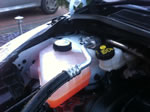 Open the bonnet, identify where you would check the engine coolant level and tell me how you would check that the engine has the correct level. Identify high/low level markings on header tank where fitted or radiator filler cap, and describe how to top up to correct level.
Open the bonnet, identify where you would check the engine coolant level and tell me how you would check that the engine has the correct level. Identify high/low level markings on header tank where fitted or radiator filler cap, and describe how to top up to correct level.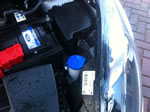 Identify where the windscreen washer reservoir is and tell me how you would check the windscreen washer level.Identify reservoir and explain how to check level.
Identify where the windscreen washer reservoir is and tell me how you would check the windscreen washer level.Identify reservoir and explain how to check level. Open the bonnet, identify where the brake fluid reservoir is and tell me how you would check that you have a safe level of hydraulic brake fluid.Identify reservoir, check against high/low markings.
Open the bonnet, identify where the brake fluid reservoir is and tell me how you would check that you have a safe level of hydraulic brake fluid.Identify reservoir, check against high/low markings.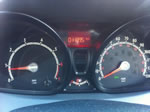 Tell me how you would check that the brake lights are working on this car. (I can assist you, if you need to switch the ignition on, please don't start the engine.Operate brake pedal, make use of the reflections in windows, garage doors, etc, or ask someone to help.
Tell me how you would check that the brake lights are working on this car. (I can assist you, if you need to switch the ignition on, please don't start the engine.Operate brake pedal, make use of the reflections in windows, garage doors, etc, or ask someone to help.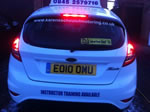 Tell me how you would check that the brakes are working before starting a journey. Brakes should not feel spongy or slack. Brakes should be tested as you set off. Vehicle should not pull to one side.
Tell me how you would check that the brakes are working before starting a journey. Brakes should not feel spongy or slack. Brakes should be tested as you set off. Vehicle should not pull to one side.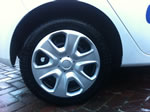 Tell me how you would check the tyres to ensure that they have sufficient tread depth and that their general condition is safe to use on the road. No cuts and bulges, 1.6mm of tread depth across the central ¾ of the breadth of the tyre and around the outer circumference.
Tell me how you would check the tyres to ensure that they have sufficient tread depth and that their general condition is safe to use on the road. No cuts and bulges, 1.6mm of tread depth across the central ¾ of the breadth of the tyre and around the outer circumference.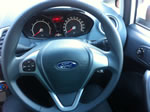 Show me/explain how you would check that the power assisted steering is working before starting a journey. If the steering becomes heavy the system may not be working properly. Before starting a journey two simple checks can be made. Gentle pressure on the steering wheel, maintained while the engine is started, should result in a slight but noticeable movement as the system begins to operate. Alternatively turning the steering wheel just after moving off will give an immediate indication that the power assistance is functioning.
Show me/explain how you would check that the power assisted steering is working before starting a journey. If the steering becomes heavy the system may not be working properly. Before starting a journey two simple checks can be made. Gentle pressure on the steering wheel, maintained while the engine is started, should result in a slight but noticeable movement as the system begins to operate. Alternatively turning the steering wheel just after moving off will give an immediate indication that the power assistance is functioning.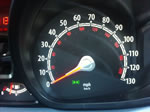 Tell me how you would check that the headlights and taillights are working. (No need to exit the vehicle). Operate switch (turn on ignition if necessary), walk round vehicle.
Tell me how you would check that the headlights and taillights are working. (No need to exit the vehicle). Operate switch (turn on ignition if necessary), walk round vehicle. Show me how you would check that the direction indicators are working. Applying the indicators or hazard warning switch and check functioning of all indicators.
Show me how you would check that the direction indicators are working. Applying the indicators or hazard warning switch and check functioning of all indicators.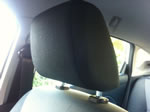 Tell me how you make sure your head restraint is correctly adjusted so it provides the best protection in the event of a crash. The head restraint should be adjusted so the rigid part of the head restraint is at least as high as the eye or top of the ears, and as close to the back of the head as is comfortable. NB. Some restraints might not be adjustable.
Tell me how you make sure your head restraint is correctly adjusted so it provides the best protection in the event of a crash. The head restraint should be adjusted so the rigid part of the head restraint is at least as high as the eye or top of the ears, and as close to the back of the head as is comfortable. NB. Some restraints might not be adjustable.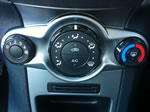 Show me how you would set the demister controls to clear all the windows effectively, this should include both front and rear screens. Set all the relevant controls including; fan, temperature, air direction/source and heated screen to clear windscreen and windows. Engine does not have to be started for this demonstration.
Show me how you would set the demister controls to clear all the windows effectively, this should include both front and rear screens. Set all the relevant controls including; fan, temperature, air direction/source and heated screen to clear windscreen and windows. Engine does not have to be started for this demonstration. Show me how you switch your headlight from dipped to main beam and explain how you would know the main beam is on whilst inside the car. Operate switch (with ignition or engine on if necessary), check with main beam warning light.
Show me how you switch your headlight from dipped to main beam and explain how you would know the main beam is on whilst inside the car. Operate switch (with ignition or engine on if necessary), check with main beam warning light.As vehicle technology advances, more and more vehicles are being equipped with electronic diagnostic systems, which inform the driver of the state of the engine fluid levels and tyre pressures. It will be acceptable for a candidate to refer to the vehicle information system (if fitted) when answering questions on fluid levels or tyre pressures.